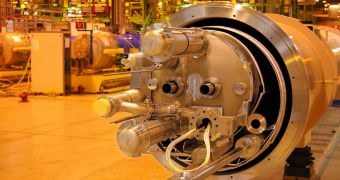The latest statements from CERN officials shed more light on the Large Hadron Collider glitch that happened more than one month ago, on September 19, and indicate that the device will not be fully operable sooner than May or June of next year. It seems that the electrical failure caused irreversible damage to 29 of the LHC's about 10,000 magnets, 24 of which are 35-ton heavy dipole magnets and 5 quadrupole ones.
Six tons of super-cold liquid helium were spilled after the weld of a superconducting wire warmed beyond the 1.9 degree Kelvin (-271.25 degree Celsius or -456.25 degree Fahrenheit) temperature that it normally operates at, causing the damage of the 2 magnets it connected and creating a huge electric arc (8.7 kiloamps) through the helium, which melted the container. The power discharge instantly fried the connecting wire, and the helium was spilled into the cooling thermos-like insulation zone.
The valves, which were supposed to permit the helium escapement, were incorrectly designed, and were so overwhelmed that the magnets were dislocated from the formed pressure. The unleashed electricity also punctured some of the pipes, allowing the helium content to spread within them as well. CERN technicians say they have enough spare magnets, and will redesign the valves with a larger error margin, based on the recent events.
The repairs, which will take place over a period of 8 months, will cost CERN about $90,000, without including the spare parts and labor – consequently, they will take much longer and be more expensive than previously believed. But, as Peter Jenni – a spokesman for the ATLAS detector – says, “We are a bit disappointed, but we all understand that in such an enterprise, things can go wrong.” Hopefully, there won't be more delays for the repairs deadline, or other errors that weren't anticipated in the design of the LHC, so that we will see some long-expected results by the middle of 2009.

 14 DAY TRIAL //
14 DAY TRIAL //